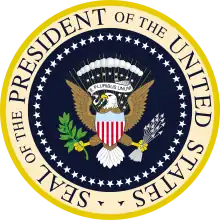AmeriCorps
AmeriCorps is a voluntary civil society program supported by the U.S. federal government, foundations, corporations, and other donors that engages adults in public service work with a goal of "helping others and meeting critical needs in the community."[1] Members commit to full-time or part-time positions offered by a network of nonprofit community organizations and public agencies, to fulfill assignments in the fields of education, public safety, health care, and environmental protection. The program is often seen as a domestic Peace Corps.[2][3] It employs more than 75,000 Americans in intensive service each year.[4]
 | |
| Agency overview | |
|---|---|
| Jurisdiction | Federal government of the United States |
| Agency executive |
|
| Parent agency | Corporation for National and Community Service |
| Child agencies |
|
| Website | nationalservice.org/americorps |
AmeriCorps is an initiative of the Corporation for National and Community Service (CNCS), which also oversees the Senior Corps and the formerly-funded Learn and Serve America.[5] It was created under President Bill Clinton by the National and Community Service Trust Act of 1993,[6] incorporating VISTA (Volunteers in Service to America) and the National Civilian Community Corps (NCCC).[7] A third division, AmeriCorps State and National, provides grants to hundreds of local community organizations throughout the United States.[8]
The program first became operational in 1994 and has expanded over time,[7] with over 80,000 members participating annually as of 2012.[9] Members may be provided low financial compensation in the form of cost-of-living allowances, student loan deferment, Public Service Loan Forgiveness, and the Americorps Education Award. Less tangible benefits include professional skill development and work experience.[10] An internal study found that participation in AmeriCorps strengthened civic attitudes and sentiment, making members more likely to choose careers in public service.[11]
Programs
AmeriCorps VISTA
AmeriCorps VISTA, or Volunteers in Service to America (VISTA), was founded in 1965 as a domestic version of the Peace Corps. The program was incorporated into AmeriCorps and renamed AmeriCorps*VISTA with the creation of AmeriCorps in 1993.[12] VISTA provides full-time members to nonprofit, faith-based and other community organizations, and public agency to create and expand programs that ultimately bring low-income individuals and communities out of poverty. There are currently over 5,000 VISTA members serving in 1,200 VISTA programs nationwide.
AmeriCorps NCCC
AmeriCorps National Civilian Community Corps (NCCC) is a full-time, residential team-based program for men and women ages 18–24. Members serve at one of four regional campuses located throughout the United States (Vicksburg, MS; Vinton, IA; Aurora/Denver, CO; and Sacramento, CA). Each campus focuses efforts on states within its region but may travel to other areas in response to national crises. Former campuses were located in Washington, DC; Charleston, SC; San Diego, CA; Baltimore, MD; and Perry Point, MD.
AmeriCorps State and National

AmeriCorps State and National is the largest of the AmeriCorps programs, and provides grants to local and national organizations and agencies, including faith-based and community organizations, higher education institutions, and public agency. Grants assist these groups in recruiting, training and placing AmeriCorps members to meet critical community needs in education, public safety, health, and the environment.[13] AmeriCorps State operates through Service Commissions in each state, such as Volunteer Florida and the Mississippi Commission for Volunteer Service; South Dakota is the only state without a Service Commission. Each state's Service Commission dispenses funding from the Corporation for National and Community Service to organizations in their states through annual grant competitions. Thousands of organizations across the nation have been awarded AmeriCorps State and National grants since the program's inception.
AmeriCorps State and National members engage in direct service activities, such as after-school tutoring or homebuilding, and capacity-building activities, such as volunteer recruitment, for the organizations they serve. After successfully completing their term of service, AmeriCorps State and National members may be eligible for an Education Award of up to $6,095 or equal to the full Pell Grant for the year in which service was approved.[14] The Education Award can pay for additional college or graduate school courses, or it can pay off existing student loans.[15] Full-time members typically complete 1,700 hours of service over 11 months; these members additionally receive a living allowance, health benefits, and child care assistance during their term.[16]
Participating organizations
According to the AmeriCorps website, since the creation of AmeriCorps in 1993 more than 250,000 individuals across the United States have served hundreds of communities in every state of the nation. Some of the programs, organizations, and institutions partnering with AmeriCorps include Communities In Schools, Jumpstart for Young Children, Public Allies, Citizen Schools, City Year, YouthBuild. Youth Volunteer Corps, YMCA, International Rescue Committee, Hands On Mississippi, Notre Dame Mission Volunteers - AmeriCorps, Girl Scouts of the USA, Boy Scouts of America, Boys and Girls Club, Big Brothers, Big Sisters, Camp Fire, College Forward, New York City Coalition Against Hunger, Habitat for Humanity, American Red Cross, the Student Conservation Association, Project Transformation, Reading Partners, FoodCorps, Minnesota Reading Corps, Teach For America , SBP, and Virginia Community Corps.
Effectiveness
While discussion has occurred about the range and efficacy of evaluating the successes of AmeriCorps,[17] there has been a variety of documentation supporting the program. AmeriCorps provided fiscal resources and personnel to support the start-up of national programs, including Public Allies and Teach For America. It also brought vital resources to established programs, including City Year, Boys and Girls Club, Big Brothers Big Sisters, JusticeCorps and the American Red Cross.[18]
AmeriCorps is reported to increase the effectiveness of community service. Successes for individual AmeriCorps members include increasing their commitment to community service, increasing community-based activism, connection to their communities, knowledge of community problems, engagement in the political process, and voting participation.[19][20]
Additionally, according to a 2007 study released by the Corporation for National and Community Service, a majority of AmeriCorps alumni within the study period claimed they had gained life and job skills, such as leadership, teamwork, time-management, and hands-on experience in a field of interest. The study further reported that 71% of alumni were incentivized to join by the prospect of earning a Segal AmeriCorps Education Award; 41% of AmeriCorps members went on to receive a 4-year college degree within three years of entering AmeriCorps.[21]
Member pledge
Most AmeriCorps VISTA members are required by federal law to take the same oath that federal employees take:[22]
I, (name), do solemnly swear (or affirm) that I will support and defend the Constitution of the United States against all enemies, foreign and domestic; that I will bear true faith and allegiance to the same; that I take this obligation freely, without any mental reservation or purpose of evasion; and that I will well and faithfully discharge the duties of the office on which I am about to enter. [So help me God.][23]
Non-VISTA AmeriCorps members take the following pledge: [24]
- I will get things done for America - to make our people safer, smarter, and healthier.
- I will bring Americans together to strengthen our communities.
- Faced with apathy, I will take action.
- Faced with conflict, I will seek common ground.
- Faced with adversity, I will persevere.
- I will carry this commitment with me this year and beyond.
- I am an AmeriCorps member, and I will get things done.
The 2002 Citizen Service Act (HR 4854), introduced by Representatives Pete Hoekstra (R-MI) and Tim Roemer (D-IN) on May 24, 2002, would have required AmeriCorps members serving in NCCC and in State and National to take the same pledge VISTA members take.[25] However, some current and former AmeriCorps members argued the proposed pledge was divisive, "militaristic and religious," and might deter recruitment.[26] Although the Citizen Service Act was approved by both the Subcommittee on Special Education and the Committee on Education and the Workforce in June 2002, the House of Representatives took no further action on the measure.[27]
See also
- Youth service
- Service learning
- National service
- ACTION, the federal agency that administered VISTA prior to the creation of AmeriCorps and the Corporation for National and Community Service
- USA Freedom Corps
References
- "What Is AmeriCorps?". Corporation for National and Community Service. Retrieved 2013-01-16.
- Jackson, Robert L. (1994-09-13). "Youths in National Service Plan Sworn In : AmeriCorps: Young recruits in domestic version of Peace Corps will work in schools, hospitals, environment to help pay their college tuition". Los Angeles Times. Retrieved 2013-01-06.
- "Frequently Asked Questions for Individuals". AmeriCorps. Retrieved 2013-01-06.
- "Americorps employs more than 80,000 Americans in intensive service each year". Retrieved 8 October 2016.
- "AmeriCorps is Changing the Minds of Congressional Republicans". The White House. 2001-01-15. Archived from the original on 2011-08-29. Retrieved 2008-12-05.
- "National and Community Service Trust Act of 1993". WikiSource. Retrieved 2013-01-06.
- "History, Legislation, and Budget". AmeriCorps. Retrieved 2013-01-06.
- "AmeriCorps State and National". AmeriCorps. Retrieved 2013-01-06.
- Leventhal, Alan (2013-01-06). "Help for the high school dropout rate". The Boston Globe. Retrieved 2013-01-06.
- "Benefits of AmeriCorps Service". AmeriCorps. Retrieved 2013-01-06.
- "AmeriCorps Longitudinal Study: Impacts of Service on Members" (PDF). AmeriCorps. Retrieved 2013-01-16.
- Frequently Asked Questions About AmeriCorps VISTA. AmeriCorps website. Retrieved 12/5/08.
- AmeriCorps State and National. AmeriCorps website. Retrieved 12/4/08.
- AmeriCorps website. Retrieved June 26, 2018
- AmeriCorps Benefits: Education Award. AmeriCorps website. Retrieved August 10, 2009.
- AmeriCorps State and National. AmeriCorps website. Retrieved August 10, 2009.
- (2004) "Transcript - March 31 AmeriCorps Rulemaking Session," Corporation for National Service. p. 7. Retrieved 8/12/07.
- Gomperts, J. "Towards a bold new policy agenda: Five ideas to advance new civic engagement opportunities among older Americans," Archived 2007-09-27 at the Wayback Machine Generations. XXX(4). p. 87.
- VeraWorks. (2006) "AmeriCorps Service Effects on Member Civic Engagement." Archived 2007-10-26 at the Wayback Machine Washington State Office of Financial Management. Retrieved 8/12/07.
- Abt Associates. "Serving Country and Community: A Longitudinal Study of Service in AmeriCorps Factsheet" Archived 2007-09-28 at the Wayback Machine. Retrieved 8/12/07.
- Shelton, LaMonica; Nicholas, Brooke; Dote, Lillian; Grimm, Robert, Jr. (May 2007), "AmeriCorps: Changing Lives, Changing America" (PDF), Corporation for National and Community Service, Office of Research and Policy Development, CNS
- "Domestic Volunteer Service Act of 1973" (PDF). Retrieved 2020-09-21.
- "5 U.S. Code § 3331.Oath of office". Cornell Law School. Retrieved 2020-09-21.
- "The AmeriCorps Pledge", AmeriCorps.gov. Retrieved 11/10/16.
- (November 29, 2002) "One pledge fits all", SFGate. Retrieved 12/5/08.
- Marquis, C. (November 21, 2002) "Revised pledge for AmeriCorps draws criticism", The New York Times. Retrieved 12/5/08.
- "House Report 110-420-Generations Invigorating Volunteerism and Education Act or the `Give Act'" Archived 2012-10-23 at the Wayback Machine. Retrieved 12/5/08.
External links
| Wikimedia Commons has media related to AmeriCorps. |


